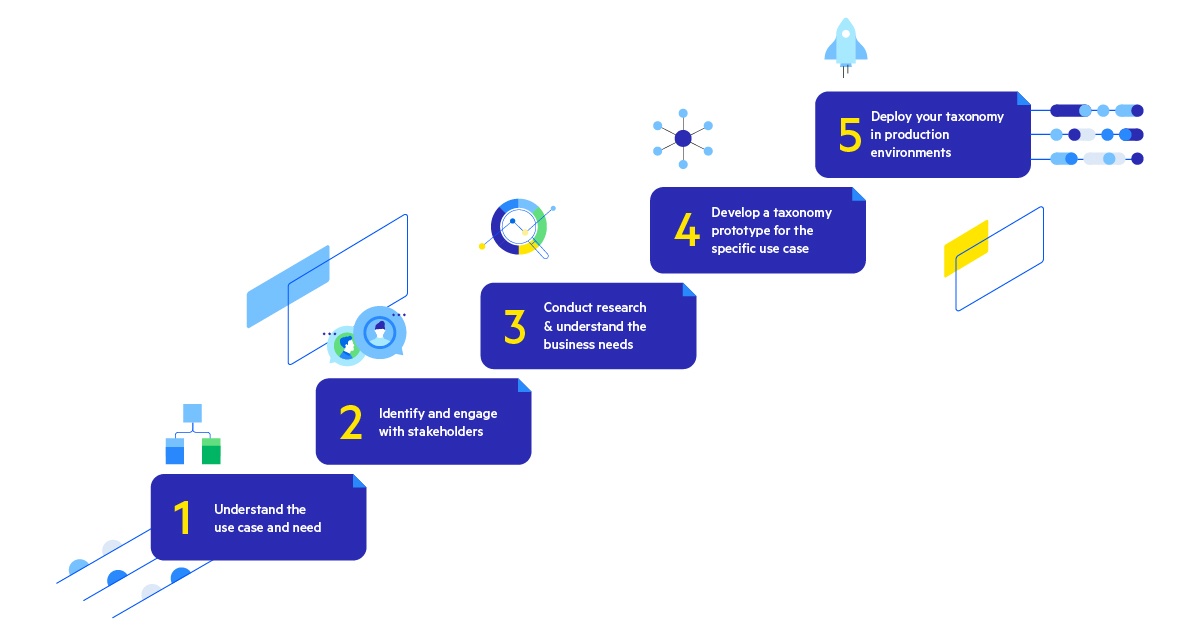Effective taxonomy management is essential for unlocking the full potential of your enterprise information. By investing efforts in taxonomy development, organizations can overcome data complexity, improve data quality and enhance their decision-making capabilities. This drives innovation, efficiency and competitive advantage in today’s data-driven landscape. But how can organizations get started?
Embarking on a taxonomy project can be daunting, but with the right approach, you can set yourself up for success from the start. Taxonomies offer tremendous value to organizations. However, they are only useful if they cover relevant topics, subjects, and concepts that are important to the enterprise. Taxonomies represent systematic tools for organizing and managing data or content into specific categories. Taxonomy management is a critical aspect of information organization, enabling businesses to structure data effectively for improved searchability, navigation and decision-making.
The Importance of Data Organization and the Need for a Taxonomy
As data scientists or knowledge workers, we all encounter numerous challenges related to managing and harnessing the power of our data. While we may no longer experience issues with collecting or connecting data, a significant challenge we face is the exponential growth of data and the diversity of data generated from various sources. This includes structured databases, unstructured documents, social media and more. We often lack a common understanding of the data we possess—leading to frustration and hours spent looking for documents.
In the ever-expanding realm of data, effective knowledge organization is paramount. Attempting to do anything meaningful with unorganized data will lead to frustration at best and invalidated results at worst. To remedy this problem, you can implement a taxonomy system to organize and structure your information coherently and systematically, enabling easier access, retrieval and analysis. Taxonomies provide a common language and structure for organizing data, facilitating collaboration, knowledge sharing and consistency across different departments and systems. Data challenges underscore the importance of effective data organization and the need for robust taxonomy management practices within organizations.
Why doesn’t everyone have a taxonomy? The process of building a taxonomy is time-consuming, the language across the enterprise isn’t always consistent and most people don’t know how to start one or don’t understand the value of a taxonomy, so they’re hesitant to give you the time and money it requires. Here we provide a step-by-step process for starting your taxonomy project in a way that will increase the efficiency of business processes involving content, unify structured and unstructured information to accelerate analytical capabilities for knowledge workers and speed up their ability to search for relevant content.
5 Steps for Building a Taxonomy Project
Starting your taxonomy project involves laying the groundwork efficiently and effectively. Every taxonomy project is unique and varies based on the specific business case. By following these steps, you can jumpstart your taxonomy project and lay a solid foundation for effective information organization and management within your organization.

Step 1: Understand the use case and need. Start your project by defining the objectives of your taxonomy project. What specific goals are you trying to achieve? What is the use case? Are you trying to improve your search capabilities, enhance your content organization or enable better decision-making? Regardless of the use case, clear objectives should be set from the start. Another key consideration is to set a scope for the project by clearly identifying the domains, subjects or content areas that it will cover.
Step 2: Identify and engage with stakeholders. Determine the stakeholders that should be part of the taxonomy project, including subject matter experts, content editors, content creators and end users. The key is to get them involved from the outset. Stakeholder engagement is critical for the success of your taxonomy project as well as understanding their needs, preferences and pain points so your taxonomy project meets their expectations.
Step 3: Conduct research and understand the business needs. Do enough research to understand the domain or subject area and confirm its importance before diving into the taxonomy development project. The existing taxonomies of the business will be a great starting point, and identifying common terminology, concepts and relationships within your business domain will ultimately influence your taxonomy design. Audit your existing content and systems. Identifying the search pattern of users, their perception of the organization and the terms they use are critical.
Step 4: Develop a taxonomy prototype for the specific use case. Don’t try to build a giant taxonomy. Focus on the specific business case and develop a prototype for the best results. Iterate on the feedback until you reach the desired outcomes by all stakeholders. If developing your own taxonomy feels daunting, licensing third-party taxonomies may be a great solution.
Step 5: Deploy your taxonomy in production environments. Your taxonomy project doesn’t stop after you deploy your taxonomy in a production environment. Organizations should continuously iterate and refine the taxonomy based on user feedback and in line with business changes. Once implemented in the businesses, establish governance processes and policies to guide taxonomy management and maintenance. For example, craft policies and standards for creating new terms and definitions, managing re-used terms and following term-naming conventions.
Better Knowledge Organization with Progress Semaphore and WAND Taxonomies
Your documents and data are not just great; they are a treasure trove of vital information for your organization. With the help of Progress Semaphore and WAND, you can bring order and structure to your data landscape. WAND taxonomies enable organizations to start their modeling efforts immediately.
WAND utilizes domain experts and library science experts to create and maintain their taxonomies. Each one is handmade with the specific industry in mind to create a prebuilt product that can be immediately imported into your system with only minor tweaking for specific company terminology. WAND provides an 80% jumpstart which allows you to turn a challenging build into a simple edit. Once the taxonomy has been imported into Semaphore, the process for using the taxonomy is simple. Semaphore can immediately begin auto-tagging your documents with the newly imported taxonomies. Almost instantly, your data will shift from being an unorganized, overwhelming mess to an organized, easily accessible set of information.
“Artificial Intelligence, Machine Learning, and Auto-Classification technologies are maturing at a rapid rate and can now efficiently utilize prebuilt curated taxonomies and intelligent metadata models to reduce the traditional model-building time by up to 90%. The business value of these combined technologies is to be able to index and classify enterprise content to enable access by the respective information consumers within the enterprise.” Said CEO of WAND Taxonomies, Ross Leher.
The true magic happens when Semaphore and WAND are used together. Each element—your documents and data, Semaphore and WAND Taxonomies—plays a unique role. But their real strength lies in their synergy. Together, they form a powerhouse that unlocks unparalleled efficiency and productivity. Semaphore enhances the capabilities of information management systems, and WAND Taxonomies provide the structured foundation needed for the meaningful classification of your documents.
It's not just a combination; it’s a collaboration that transforms your data and documents into a seamlessly organized, easily navigable and highly valuable asset for your organization. In essence, they are not merely tools; they are partners, working in harmony to elevate the efficiency and impact of your information management strategy.
Conclusion
Embarking on your taxonomy project is a strategic investment that can yield significant benefits for your organization’s information management processes. With a well-organized and effectively managed taxonomy in place, you’ll empower your organization to navigate the complexities of information management with ease—driving efficiency, productivity and innovation.
Discover how you can leverage Progress Semaphore and WAND to start your own taxonomy project.

Gerard Rebalsky
Gerard is a Sales Manager for Semaphore at Progress. Gerard has a record of accomplishment in building synergies across multimillion-dollar enterprises to drive revenue and spur growth. Leveraging his deep understanding and sales and marketing operations experience, he excels at leading high-performing teams and creating business development strategies that exceed expectations. By cultivating collaborative partnerships with customers, partners and prospects, he drives growth and delivers results by tying customer needs and securing business buy-in. Outside of work, Gerard enjoys playing with his neighbors' dogs, volunteers at local animal shelters and is passionate about socioeconomic issues.

